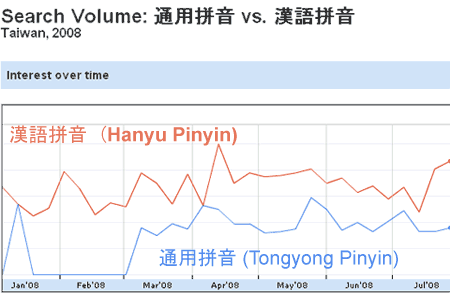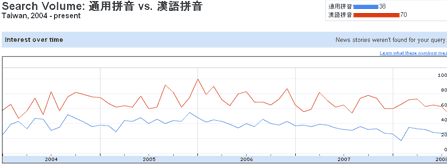Taiwan’s still official but probably-not-long-for-this-world romanization system for Mandarin is Tongyong Pinyin. Tongyong Pinyin, however, is basically unknown outside Taiwan and, in truth, very little known even within Taiwan. (And many of those — like me — who do know it don’t like it.) But still, it’s what the Chen administration forced into use on highway signs, within train stations, and on some other signage throughout the country. So there’s certain to be some interest for it here. But in Taiwan how does interest in it compare against interest in Hanyu Pinyin, use of the latter system being regarded as something close to a sign of the apocalypse among some Tongyong supporters? The new Google Insights provides some clues.
Here’s a relative look at Google searches from Taiwan in 2008 for the terms “漢語拼音” (Hanyu Pinyin) and “通用拼音” (Tongyong Pinyin).

In Taiwan, searches for Hanyu Pinyin have clearly been more popular this year.
What about in the longer term? Below is a chart from 2004 to the present. (The lines are a little different because in the long-term chart averages are by month; but the monthly averages probably give a clearer picture anyway.)

Again, interest in Hanyu Pinyin comes out on top — consistently — even in Taiwan.
Not surprisingly, in searches worldwide, Tongyong Pinyin basically doesn’t even register against Hanyu Pinyin, so great is the disparity.
If you’d like to run some searches on your own, note that Google Insights distinguishes between traditional and “simplified” Chinese characters, i.e., a search for “漢語拼音” will yield substantially different results than one for “汉语拼音”.

I wish it was probably-not-long-for-this-world, but if you ask the
Executive Yuan when can we please get “Tongyong Pinyin” off our backs,
you’ll still just get the “we’ve already made up our minds, and it’s
Tongyong Pinyin” answer, as if A-Bian was still president.
And you blew the URL, which is http://www.google.com/insights/search/
Oops. The link’s fixed now. Thanks.
I haven’t spoken with anyone in the Executive Yuan since the election. If that’s what they’re still saying, that’s certainly discouraging. But I do think this will get sorted out before Ma leaves office.
On the other hand, I have spoken in recent months with officials with the Taipei City Government, who, in typical Taiwan bureaucratic fashion, say that the city’s entire romanization guidelines would have to be changed in order to correct some stylistic errors even on *new* signs (i.e., covering over the nicknumbering system — but more on that some other time). “Frustrated” doesn’t even begin to cover my reaction to this.
I prefer the Hs spelling over the X spelling for the sound that they represent, even though it is one extra letter to type (though H and S are more conveniently located on the keyboard than X). I don’t know anything else about Tongyong Pinyin.
Words beginning in X and Q baffle most westerners. Of course, the point of Romanization is to represent the sounds of Chinese consistently, and to to make it easier for Westerners to speak.
My girlfriend’s last name is Xu. She says she doesn’t like the name because nobody knows how to pronounce it. Though an H before an S is not common, if it appears at all, I think it would be easier for someone to figure out how to pronounce Hs (or at least approximate it. I’ve tried to learn it, but can’t seem to get it close enough to the right sound to satisfy my girlfriend).
In Canada, we retain a number of archaic spellings, like colour vs. color. I think nationalism is a significant factor. Idiotic rants ensue.
I notice in the graphs you present that, while Hanyu Pinyin is definitely the more common throughout, the difference in numbers seems to be about the same. There are some fluctuations, but over time Tongyong does not appear to be losing much ground.
Hi, Randy:
“Hs” is representative of Wade-Giles. Tongyong Pinyin doesn’t use that combination of letters in any single syllable. What Hanyu Pinyin spells “Xu” Tongyong Pinyin spells “Syu”. Wade-Giles would spell this “Hsü” — though this is commonly written without the umlaut: Hsu.
“Hs,” of course, can present its own troubles to native English speakers uninformed by the rules of Wade-Giles and the pronunciation of Mandarin. For example, my wife’s given name is “Hsin-chun” (Hanyu Pinyin “Xinchun”); the “chun” usually gets dropped when my relatives say her name. It took me quite a while to get my father not to pronounce “Hsin” as “Ha-sheen,” as if she had some sort of Semitic nickname.
As for Tongyong not losing much ground, Jidanni may well be right. Taiwan’s bureaucracy is set up in a way that makes it very difficult to change anything.
I have been teaching English in Taiwan for many years, thus I know that languages are not logical. However, there are some aspects to consider when choosing between Hanyu and Tongyong.
My main argument for Hanyu is that it is used and taught in schools throughout Mainland China, the United States and Canada, not to mention most European schools that teach Mandarin.
The Tongyong pinyin is regional, it is based on a hard-to-understand Wade-Giles system, its use is limited mainly to Taiwan, therefore it is not practical, and there is no hope that it will ever replace the far more wide-spread Hanyu pinyin.
Academia Sinica took a stand years ago and favored Tongyong, but their reasoning was political: “If it serves Communist China, we don’t want it”. Not exactly a scientific stand. I do hope that soon common sense will prevail even in the Taiwanese bureaucratic circles.
B., Andrew
Xinzhu City (a.k.a. Hsinzhu, Xinchu, Shinchu and Hsinchu)
Xinzhu City … a.k.a. Sinjhu? You left that one out =p
No, honestly, Tongyong Pinyin looks too funny sometimes, as if it were designed to incorporate sounds from Ah-Bian’s accent!
(Addendum)
It seems, however, that the people and/or government of Xinzhu have totally rejected Tongyong Pinyin. Good for them. A search for “Sinjhu” on Google reveals only 587 results (even though you see “Sinjhu” on highway signs al over the place). Haha!
Quick note: Although “Sinjhu” only has 600 results and “Xinzhu” has more than 100% more at 68,500, both of these pale in comparison to “Hsinchu,” which has 4,170,000. Although this definitely underscores the fact that they’re not adopting Tongyong, I don’t think this is particularly good evidence that they’re wholesale adopting Hanyu, either.
Let’s see, the official names of Xinzhu City and County themselves are in
Wage-Giles (due to nation-wide grandfathering clause).
The names within Xinzhu City are in Hanyu Pinyin (due to local Blue
government choice) and within Xinzhu County are in Tongyo… wait. I
don’t want to play anymore.
News flash: No more funding for Tongyong Pinyin, 中文譯音採漢語不補助通用
http://udn.com/NEWS/NATIONAL/NATS5/4520826.shtml etc. Monitor
http://news.google.com.tw/news?q=拼音&ie=UTF-8 to keep on top of the developments.
It is impossible to talk about something like language and not have politics involved in some way. To the extent adopting the romanization style used in China (which does not represent any particular help in pronouncing Chinese – to wit, using “cui”, which is a word no foreigner can pronounce without knowing the system, and dozens of other examples) appears to fit into the current government’s deconstruction of Taiwan as a sovereign state, I would urge Taiwanese to resist strenuously.
The system used in China offers no advantage over Tongyong Pinyin for travelers to Taiwan who speak no Mandarin, and gives up something far more important – national identity.
Randy’s comment was accurate in this respect. What is next? Will “Mr.” Ma follow with outlawing traditional Chinese characters to adopt China’s style of writing, too? He has already reduced Taiwan to a “region” of China.
That being said, linguists focus on linguistic niceties instead of helping travelers pronounce foreign words. Romanization should allow a foreigner to instinctively say a foreign word. To that extent, “Hsinchu”, and words spelled in this way make more sense than linguistic styles that hunt for unused characters to represent other counter-intuitive sounds, like using “X” to represent the “sh” sound.
The government’s efforts to adopt Hanyu Pinyin have nothing to do with pronunciation, and everything to do with sinication of Taiwan. Welcome back to the days when everything Taiwanese was shunned or outlawed. Today, Hanyu Pinyin, tomorrow, goodbye Big 5, and after that, we might as well register with the CCP. No thank you.
[Correction] The government’s efforts to adopt Hanyu Pinyin have nothing to do with pronunciation, and everything to do with SINICIZATION of Taiwan. Welcome back to the days when everything Taiwanese was shunned or outlawed. Today, Hanyu Pinyin, tomorrow, goodbye Big 5, and after that, we might as well register with the CCP. No thank you.
Longhwa: there is life after Big 5: UTF-8, you are using it right now.
Don’t be afraid. 公尺也比台尺更長。公元年也不錯。 Now no need for
Commie invasion to fix Pinyin!
Wonder if the ministers know that “Hsinchu”, “Taipei” etc. is not Hanyu Pinyin.
Better Forumosa link: http://www.forumosa.com/taiwan/viewtopic.php?f=8&t=73028
I got a mail about the inventor of “Tongyong Pinyin”:
From: Meow
Subject: 余伯泉的末日 Yu Boquan’s End
To: jidanni@jidanni.org
http://www.udn.com/2008/9/19/NEWS/OPINION/X1/4523994.shtml